Most popular music is written in common time: four quarter notes to every bar. Written as 4/4, this time frame presents infinite opportunities for creative expression. This is largely what DJs play in – but in the interest of expanding your horizons as a live performer, today we’ve got a great piece that acts a primer to odd time signatures. Specifically, we’ll talk about how drum machine users can program their devices to play with some of the odder time signatures out there.
Even in complex polyrhythmic music such as Afrobeat or Jazz, the time signature is most often 4/4. In this time signature, interest is created through beat displacement. Regardless of its commonality, that time matrix provides a lot of space in which to move – and dancers love it.
For music makers inclined to further experimentation, diving into the ins and outs of odd time can be a gateway to new modes of beat-making and cultural forms of expression. If you’re in a creative funk, odd times are a route to fresh ideas that arise out of a new way of listening. With no end in mind, entirely new genres can emerge. Playing these types of beats as a live DJ means knowing how to screw with the minds and feet of your listeners in ways they didn’t anticipate – but they’ll love you for it.
What are the odds?
Before jumping in, let’s get some idea of what an “odd” time signature is. It’s not that it sounds odd – rather, it is mathematically structured so the number of beats in the bar – top number – can’t be divided by 2 or 3. Yes, 3/4 appears to be odd, but it’s often resolved to 6/8.
For example: 12/8, although found throughout complex African polyrhythmic music, is not odd – but 5/4, 5/8, 7/4, 7/8, 11/16, and 21/16 are. Musical terminology is a strange field littered with theoretical impossibilities and esoteric arguments. We’ll save the deep dive stuff for another time.
Here, let’s focus on two frequently used odd times: 5/4 and 7/8. 5/4 appears across the spectrum of genres, including Jazz (Dave Brubeck’s Take Five), alternative (Radiohead’s Fifteen Steps & Morning Bell) and pop (Taylor Swift’s Tolerate It).
7/8 has also been used by numerous artists with wild affect. Listen to the song “7 Ways” by Now vs Now for some deep 7/8 explorations:
Machine Learning: Seeing the beats
In order to build these time signatures, a drum machine machine needs three parameters – Last Step, Pattern Length & Note Value. Used in conjunction with one another, these parameters allow the creation of numerous types of odd times.
Rather than use traditional notation, I’ll use the sixteen-button layout of the sequencer as the visual guide. I’m a drummer and we have a particular way to count out notes – which can be incredibly helpful to those who are learning how to program beats.
First, let’s choose the Note Value we want to use. By default, sequencers are set to 16th notes. This is a good place to start. as it is visually in line with the four quarters that make up the physical interface. When counting across the interface, one button is a 16th, two equal an 8th, four equal a quarter, or 4th – the note value most often referred to as a “beat”.
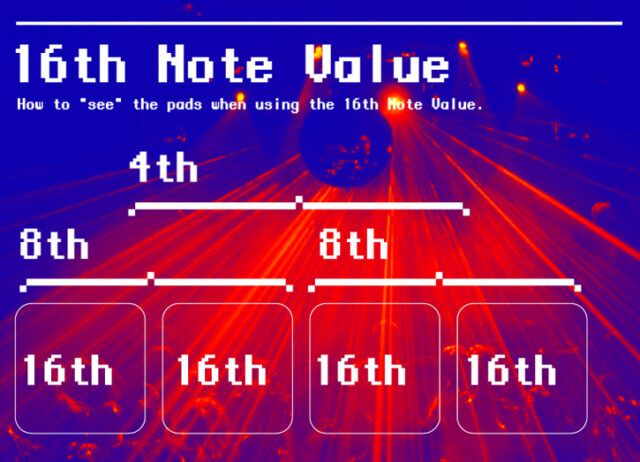
Building the 5/4 pattern requires twenty 16th notes or forty 32nd notes. This means our pattern extends the beats across the physical bar on our machine. If using 16th notes on a four-part machine, you can make a two bar pattern. If using 32nd notes, you can make a one bar pattern.
Either way, set the Last Step at 10 for each instrument /part. Within the Electribe, this feature is applied part by part. This may seem a bit tedious, but keep in mind, you can set some instruments to play 5/4 while others remain at 4/4. This creates a Poly-metric beat that resolves to the One every four bars of 5/4. For example, the Gorillaz’ song “5/4 (Animatic)” is built on a 5/4 guitar pattern played over a 4/4 drum beat. The creative possibilities are infinite.
Once you’ve set these parameters, you’re ready to build the pattern. Let’s take a look at the structure on the machine itself.
Think like a drummer, count like a child
Counting like a drummer is simple once you understand the basic terminology. A drummer breaks down the single beat into 16ths by counting “1-e-&-a, 2-e-&-a, 3-e-&-a, etc.” Each number and letter corresponds to a 16th note.
Counting out 16ths this way is a great mental tool for all sorts of beat making, as it gets down into the grain of the music. Unless you invent a way of counting out 32nds, consider all those interstitial notes as open space for displacements and all sorts of musical fairy dust. A good rule when counting is: if you play fast, count big; if you play slow, count small.
When using the 16th note value to build the 5/4, the counting mode looks like this:
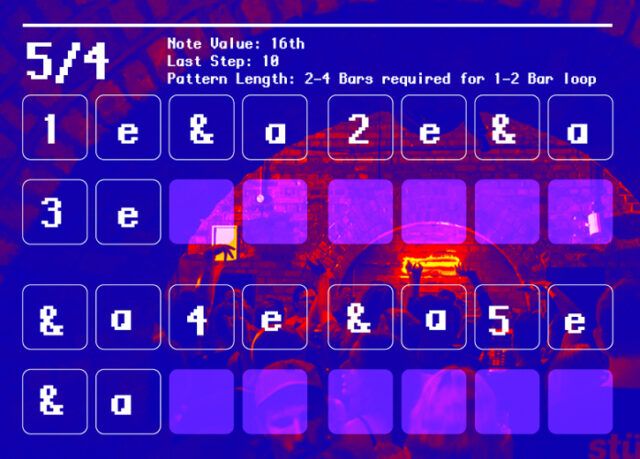
When using the 32nd not value, the counting mode looks like this:
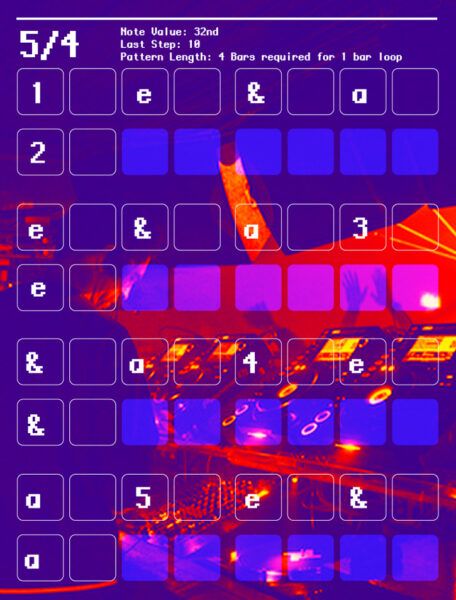
You can see how the musical 5/4 bar is built across the physical bar line within the machine. This is necessary in order to maintain the metrical symmetry required when building this odd time signature.
Musical Tip: when beginning to build a 5/4 beat, put a simple marker at the One, like a big 808 kick or some Tibetan gong. This marker will help you begin to build a beat within the time as you get a feel for the groove.
5/4 with Triplet 8th Note Values
Now that you know the general concept and practical application, let’s have a go at using Triplet note values. The drummer’s approach to counting Tri-8ths is “1-ta-ah, 2-ta-ah, 3…”.
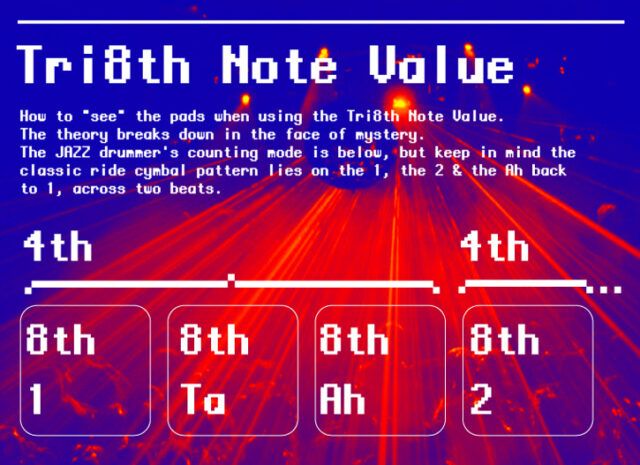
How many 8th note triplets does it take to build the pattern? If there are three 8ths in each 4th, then we end up with fifteen 8ths per musical bar. Put the Last Step at 10 for each part, then shorten the Length of your Pattern to three physical bars.
Now, you have 30 8th notes and two bars of 5/4. Count across the layout like this:
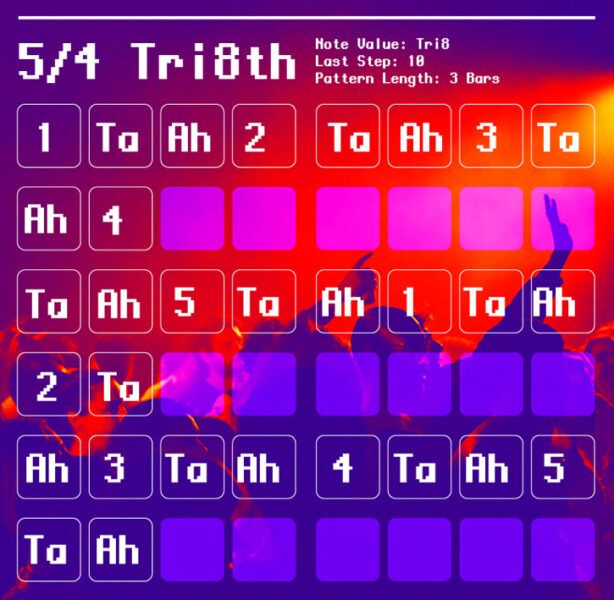
Triplet 16ths require 60 notes to make a bar of 5/4. Have a go and see what you can do.
Seven Steps: Subtract one 8th and what do you get?
Unlike the 5/4 beat pattern that extends beyond the visible bar line of the machine, 7/8 remains contained within it.
What is 7/8? Think of it as 4/4 minus one 8th and count accordingly: 1-e-&-a, 2-e-&-a, 3-e-&-a, 4-e / 1…
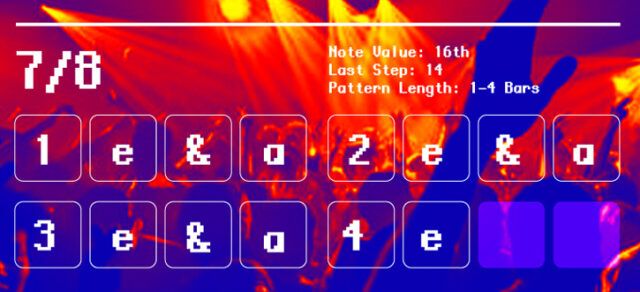
It’s simply subtraction – which allows you to use a four bar pattern, with the potential of creating a complex, evolving beat. When working with 16th or 32nd note values, set the Last Step at 14. As with 5/4, the 32nd note value will double your pattern length – this time to two bars.
While 5/4 can have a subtle extended feel, 7/8 truncates the usual expectation of the 4/4 beat. It’s a great one to drop into a 4/4 song every so often and works well as a chorus or bridge structure. But again, whole songs have been written in this mode and it contains a universe of potential in itself.
Ancient Rules meet Future Tech
As growing musicians, our development is multifaceted. With the development of so many new instruments and software options, it’s always good to return to musical fundamentals. These never change.
Understanding how music theory relates to the machines we use develops both our technical skills and can refresh our creative spirit. We grow artistically as we learn to integrate the unchanging knowledge of the past with the technical advancements of the current age.
Have fun and stay creative!





